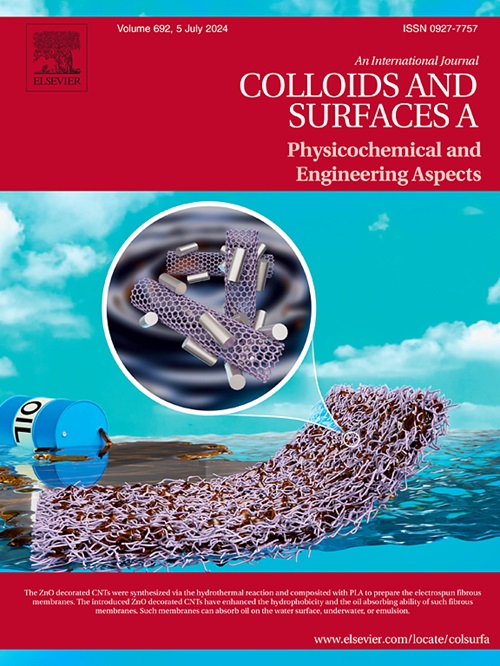From agricultural waste to green corrosion inhibitors: High-performance rapeseed meal extracts for cold-rolled steel in acidic media
IF 4.9
2区 化学
Q2 CHEMISTRY, PHYSICAL
Colloids and Surfaces A: Physicochemical and Engineering Aspects
Pub Date : 2025-07-04
DOI:10.1016/j.colsurfa.2025.137649
引用次数: 0
Abstract
Rapeseed meal, an agricultural by-product rich in heterocyclic and nitrogenous compounds, is a novel and environmentally friendly corrosion inhibitor for cold rolled steel (CRS) sheets in citric acid. The corrosion inhibition efficiencies of reflux and ultrasonic extracts (RMRE and RMUE) reached 90.88 % and 87.86 %, respectively, which is superior to many synthetic corrosion inhibitors. Both extracts follow the Langmuir isotherm and form a protective layer by mixing chemisorption and physisorption. RMRE and RMUE increased the charge transfer resistance by nearly 10-fold and reduced the corrosion current density by 90 % at 50 °C, while RMRE and RMUE significantly reduced the surface roughness, suggesting that they were effective in mitigating citric acid attack. XPS characterization showed that the protective inhibition layer formed on CRS originated from the polar functional groups in the RME molecule. Theoretical simulations show that the inhibition effect is due to electron-rich aromatic rings, N/O-heterocycles, and carbonyls, which are active sites adsorbed on the surface of Fe (0 0 1). The high efficiency, low cost, and biodegradability of RMRE and RMUE make them viable and green alternatives to toxic inhibitors.
从农业废弃物到绿色缓蚀剂:用于酸性介质中冷轧钢的高性能油菜籽粕提取物
菜籽粕是一种富含杂环化合物和氮化合物的农业副产物,是一种新型的环保型冷轧钢板柠檬酸缓蚀剂。回流提取液和超声提取液(RMRE和RMUE)的缓蚀效率分别达到90.88 %和87.86 %,优于许多合成缓蚀剂。两种萃取物均遵循Langmuir等温线,通过混合化学吸附和物理吸附形成保护层。在50 °C时,RMRE和RMUE使电荷转移电阻提高了近10倍,腐蚀电流密度降低了90% %,而RMRE和RMUE显著降低了表面粗糙度,表明它们有效地减轻了柠檬酸侵蚀。XPS表征表明,CRS上形成的保护抑制层来源于RME分子中的极性官能团。理论模拟表明,这种抑制作用是由于富电子芳香环、N/ o杂环和羰基,它们是吸附在Fe(0 0 1)表面的活性位点。RMRE和RMUE的高效、低成本和可生物降解性使它们成为有毒抑制剂的可行的绿色替代品。
本文章由计算机程序翻译,如有差异,请以英文原文为准。
求助全文
约1分钟内获得全文
求助全文
来源期刊
CiteScore
8.70
自引率
9.60%
发文量
2421
审稿时长
56 days
期刊介绍:
Colloids and Surfaces A: Physicochemical and Engineering Aspects is an international journal devoted to the science underlying applications of colloids and interfacial phenomena.
The journal aims at publishing high quality research papers featuring new materials or new insights into the role of colloid and interface science in (for example) food, energy, minerals processing, pharmaceuticals or the environment.

 求助内容:
求助内容: 应助结果提醒方式:
应助结果提醒方式:


